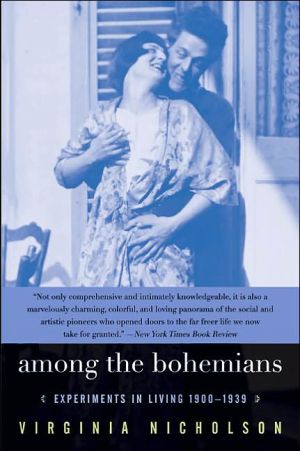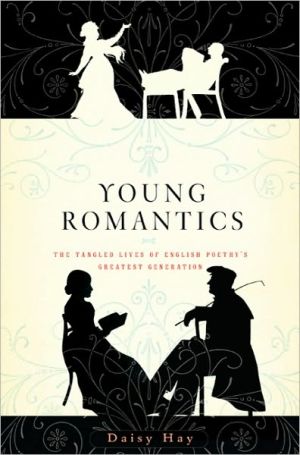Among the Bohemians: Experiments in Living 1900-1939
They ate garlic and didn't always bathe; they listened to Wagner and worshiped Diaghilev; they sent their children to coeducational schools, explored homosexuality and free love, vegetarianism and Post-impressionism. They were often drunk and broke, sometimes hungry, but they were of a rebellious spirit. Inhabiting the same England with Philistines and Puritans, this parallel minority of moral pioneers lived in a world of faulty fireplaces, bounced checks, blocked drains, whooping cough, and...
Search in google:
They ate garlic and didn't always bathe; they listened to Wagner and worshiped Diaghilev; they sent their children to coeducational schools, explored homosexuality and free love, vegetarianism and Post-impressionism. They were often drunk and broke, sometimes hungry, but they were of a rebellious spirit. Inhabiting the same England with Philistines and Puritans, this parallel minority of moral pioneers lived in a world of faulty fireplaces, bounced checks, blocked drains, whooping cough, and incontinent cats.They were the bohemians.Virginia Nicholson — the granddaughter of painter Vanessa Bell and the great-niece of Virginia Woolf — explores the subversive, eccentric, and flamboyant artistic community of the early twentieth century in this "wonderfully researched and colorful composite portrait of an enigmatic world whose members, because they lived by no rules, are difficult to characterize" (San Francisco Chronicle).The New YorkerIn a vibrant catalogue of anecdotes and tragicomic episodes, Nicholson pays homage to British writers and artists who challenged convention before the Second World War. Living for art could exact a price—Robert Graves, hoping to subsidize his writing, made a disastrous foray into shopkeeping, while a destitute Dylan Thomas used his books as furniture. For Nicholson, such recklessly hand-to-mouth living is downright heroic. Although the eccentric domestic arrangements of the Bloomsbury group are a familiar topic, she casts her net wide to include lesser-known figures like Nina Hamnett, a fixture at London’s Café Royal, and Betty May—the cocaineaddicted model of the sculptor Jacob Epstein—whose signature dish was grilled mouse on toast.
List of IllustrationsLine Drawing AcknowledgementsIntroduction1Paying the Price12All for Love313Children of Light674Dwelling with Beauty995Glorious Apparel1286Feast and Famine1637New Brooms1948The Open Road2219Evenings of Friendliness249Epilogue281App. A: Monetary Equivalents291App. B: Dramatis Personae292Notes on Sources312Select Bibliography325Acknowledgements333Index337
\ Brooke Allen… Among the Bohemians is not only comprehensive and intimately knowledgeable, it is also a marvelously charming, colorful and loving panorama of the social and artistic pioneers who opened doors to the far freer life we now take for granted. \ — The New York Times\ \ \ \ \ The New YorkerIn a vibrant catalogue of anecdotes and tragicomic episodes, Nicholson pays homage to British writers and artists who challenged convention before the Second World War. Living for art could exact a price—Robert Graves, hoping to subsidize his writing, made a disastrous foray into shopkeeping, while a destitute Dylan Thomas used his books as furniture. For Nicholson, such recklessly hand-to-mouth living is downright heroic. Although the eccentric domestic arrangements of the Bloomsbury group are a familiar topic, she casts her net wide to include lesser-known figures like Nina Hamnett, a fixture at London’s Café Royal, and Betty May—the cocaineaddicted model of the sculptor Jacob Epstein—whose signature dish was grilled mouse on toast.\ \ \ Publishers WeeklyNicholson, granddaughter of painter Vanessa Bell and great-niece of Virginia Woolf, is uniquely qualified to write about the experimental lifestyle of her grandparents' generation. The early 20th-century British bohemians-Bloomsbury and their extended circles, and lesser-known rebels like Roy Campbell and Jacob Epstein-rejected bourgeois Victorian values and embraced life as art, open marriage, Rousseau-influenced education and even poverty. Perhaps because she is an insider (despite having been born well after its heyday), Nicholson is able to communicate the ideals and desires of this generation without romanticizing it. The exhilaration of the bohemians' freedom and the hardships of the poverty in which many chose to live are equally portrayed. Their children place a golden haze on their youth but also blame their parents for not providing a rigorous education and a few rules to guide their way. The reader could also easily get impatient with how these talented individuals seemed determined to destroy themselves (the epilogue in particular reads like a catalogue of lives left ravaged by passions), but Nicholson effectively argues that theirs was the energy of true rebellion and implies that the excess was necessary to break with the constricting bonds of the past-and that the circle of bohemia ultimately changed how we all live. Although this account is written in a neutral, almost dry style as Nicholson examines the bohemians' daily lives thematically (sexual freedom, child-rearing, styles in clothing and interior decoration, etc.), the intimate conversations and salacious details related still titillate like gossip. Readers interested in the art, literature and personalities of this era will not be disappointed. B&w photos, illus. (Mar. 1) Copyright 2004 Reed Business Information.\ \ \ \ \ Library JournalBetween the end of the 19th century and World War II, Bohemia, a near-mythical community of artists and writers, flourished in England. The inhabitants of this realm-who included Virginia Woolf, Dylan Thomas, and painter and sculptor Augustus John, among others-exulted in their newfound liberation from the stultifying morality and staid artistic principles of Victorian England. Nicholson, the granddaughter of Vanessa Bell and great-niece of Virginia Woolf, draws upon her firsthand experiences of these personalities as well as popular contemporary portraits to uncover artifacts of their daily life, such as, for example, the kinds of dishes and furniture found in their houses and the kinds of clothes they popularized. Demonstrating through such excursions that even when it came to the little details, the Bohemians saw themselves as challenging conventional propriety and taste, Nicholson characterizes them as idealists, romantics, and sensualists who were contemptuous of material wealth and conventional propriety. Although this disorderly study of the lives of the Bohemians provides interesting moments of insight about lesser-known personalities in the group, it merely rehashes what we have long known about their revolutionary artistic and moral practices as well as their influence on contemporary art. Recommended primarily for larger libraries.-Henry L. Carrigan Jr., Lancaster, PA Copyright 2004 Reed Business Information.\ \ \ \ \ Kirkus ReviewsAfter surveying grandmother Vanessa Bell's home in Charleston: A Bloomsbury House and Garden (not reviewed), Nicholson moves on to a broader but related subject: lifestyles of the poor and avant-garde. "I make no apology for my fascination with the laundry-list view of history," writes the author, who deems domestic arrangements and personal habits "the kind of detail I find not only revealing but indispensable to understanding." This everything-including-the-kitchen-sink approach is most effective when applied to less familiar material. Chapters on bohemian attitudes toward marriage, sex, and feminism tend to degenerate into, yes, laundry lists of famously unconventional menages (Laura Riding, Robert and Nancy Graves; Duncan Grant, Vanessa and Clive Bell, etc.) and yet another portrait of New Women scandalizing the bourgeoisie with their short hair and cigarettes. But when Nicholson delves into childrearing, clothes, food, and housework, she vividly delineates just how revolutionary Britain's early-20th-century bohemians were. (She seems unaware that an American avant-garde was pursuing a similar course.) The author's resume of the ridiculous amount of tight-fitting attire well-bred Edwardians, male and female, had to change in and out of several times a day, for example, reminds us how liberating were the loose, colorful garments painter Augustus John and others wore, romantically emulating carefree gypsies. Dirty, squalid garrets make more sense after Nicholson points out that the alternative before modern appliances was a houseful of servants, the money to pay them, and hours spent supervising them. The avant-garde prided themselves on caring about art, not appearances, and while theauthor doesn't ignore the contradictions involved in generally middle-class rebels living like the most disreputable poor, she respects their commitment to a freer existence. As well as the usual Bloomsbury suspects, Nicholson draws her examples from other names well known in British cultural gossip: Cyril Connolly, Nancy Cunard, Dylan and Caitlin Thomas, Ford Madox Ford, etc., etc. Entertaining social history, though the author's fondness for long quotes and many, many examples make it more fun to browse than to read cover-to-cover. Agent: Caroline Dawnay/PFD\ \








